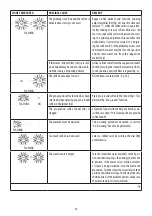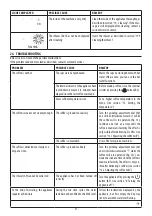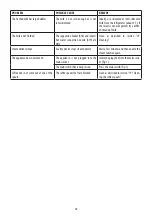
34
• Descaler contains acids which may irritate the skin and
eyes. It is vital to respect the manufacturer’s safety warn-
ings given on the descaler pack and the warnings relating
to the procedure to follow in the event of contact with the
skin and eyes.
• It is important to use De’Longhi descaler only. Using un-
suitable descaler and/or performing descaling incorrectly
may result in faults not covered by the manufacturer's
guarantee.
1. Turn the appliance on and wait until it is ready for use.
2. Empty the water tank (A7) and remove the water softener
filter (C4) (if present).
3. Pour the descaler (C3) into the water tank up to the level
A
(corresponding to a 100ml pack) marked on the back of the
tank (fig. 30), then add water (1 litre) up to level
B
(fig. 30).
4. Place an empty container with a minimum capacity of 1
litre under the cappuccino maker (A18) and coffee spouts
(A11) (fig. 31).
5. Press and hold the
button (B5) for at least 5 seconds
to confirm that you have added the solution and begin the
descaling procedure. The
light in the button remains
on steadily to indicate that the descaling programme has
begun. The
light flashes telling you to turn the steam
dial to the
l
position.
Important! Danger of scalding
Hot water containing acid flows from the hot water/steam and
coffee spouts. Take care to avoid contact with splashes of hot
water.
6. Turn the steam dial (A21) a half turn anticlockwise to the I
position. The descaler solution flows out of the cappuccino
maker into the underlying container.
The descaling programme automatically performs a series
of rinses and pauses to remove all the scale. It is normal for
several minutes of inactivity to elapse between rinses.
After about 25 minutes, the water tank is empty and the
and
lights flash. Turn the steam dial clockwise as far as it
will go to the 0 position.
7. The appliance is now ready for rinsing through with clean
water. Empty the container used to collect the descaler
solution. Extract the water tank, empty, rinse under run-
ning water, fill with fresh water up to the MAX level and put
back in the appliance: the
light flashes.
8. Place the container used to collect the descaler solution
empty under the cappuccino maker and coffee spouts (fig.
31).
9. Turn the steam/hot water dial to the
I
position to begin
rinsing. Hot water is delivered first from the cappuccino
maker, to continue and end with the coffee spouts.
10. When the water tank is completely empty, the
and
lights flash on the control panel. Turn the steam/hot
water dial to the
0
position.
11. Empty the container used to collect the rinsing water. Re-
move the water tank, replace the water softener filter (if
removed previously), fill the tank up to the MAX level with
cold water and insert in the appliance. The
steam
light flashes.
12. Place the container used to collect the rinsing water empty
under the cappuccino maker;
13. Turn the steam/hot water dial to the
I
position. Rinsing
continues from the cappuccino maker only.
14. When it finishes, the
steam light flashes on the con-
trol panel. Turn the steam/hot water dial to the
0
position.
15. Top up the water tank with fresh water to the MAX level
and put back in the machine.
The descaling cycle is now complete.
Please note!
• If the descaling cycle is not completed correctly (e.g. no
electricity) we recommend repeating the cycle;
• After descaling, it is normal for the grounds container (A13)
to contain water;
• If the water tank has not been filled to the MAX level, at
the end of descaling, the appliance requests a third rinse to
guarantee that the descaler solution has been completely
eliminated from the machine's internal circuits.
21. SETTING WATER HARDNESS
Descaling is necessary after a period of operation established
according to the water hardness set.
The machine is set by default for a hardness level of 4. The ma-
chine can also be programmed according to the hardness of the
mains water in the various regions so that the machine needs to
be descaled less often.
21.1 Measuring water hardness
1. Remove the “TOTAL HARDNESS TEST” indicator paper (C1)
from its pack (attached to the English instructions);
2. Immerse the paper completely in a glass of water for one
second;
3. Remove the paper from the water and shake lightly. After
about a minute, 1, 2, 3, or 4 red squares form, depending
on the hardness of the water. Each square corresponds to
one level;




















